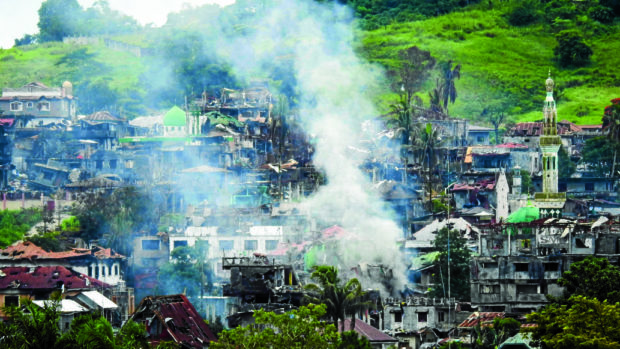Maute, Abu Sayyaf terrorists break up into small groups

Smoke billows from burning houses as fighting between government troops and Islamist militants continues in Marawi on the southern island of Mindanao on July 3, 2017. AFP PHOTO / FERDINANDH CABRERA
MARAWI CITY—The Maute gunmen and their Abu Sayyaf allies have split into small groups as government troops advance for the kill in what may be the final stages in the military campaign to retake Marawi from the Islamic State-linked terrorists holed up in the city.
Seven weeks after the fighting erupted on May 23, government forces have pushed the terrorists into a square-kilometer box in Marawi’s commercial district, where military commanders are looking to finish the fight by pummeling the terrorists’ positions with airstrikes and artillery fire, and a final close-quarter gun battle.
But the terrorists, who have pledged allegiance to the Islamic State (IS) jihadist group in the Middle East, have blunted the impact of the aerial and ground attacks by spreading out in small groups.
Sitting ducks
It is a strategy aimed at forcing government troops to enter the box and present themselves as sitting ducks for terrorists nestled in high-rise buildings.
The strategy is also designed to break up the government force into small groups that can be easily wiped out from elevated positions.
Military commanders, however, are not saying whether they see through the terrorists’ strategy.
All they say is that the terrorist force has been cut down to a few men and these fighters appear to be running out of ammunition.
Lt. Col. Gerald Bautista, commander of Marine Battalion Landing Team 7, said on Wednesday that in his jurisdiction, no more than 10 terrorists were engaging his troops.
“Their advantage is they know the area and they are prepositioned,” he said.
But Bautista said his troops were pressing the operation to clear their sector of terrorists.
Hit and run
“It’s like this every day for the past weeks. We engage them and they fight back. Then they transfer to other hiding places,” he said.
A soldier who spoke to the Inquirer on condition of anonymity said his unit had not encountered intense resistance from the terrorists on recent days.
“Sometimes one or two of them would fire at us,” said the soldier, who had been on the front line since arriving in Marawi in early June.
Lt. Col. Christopher Tampus, the commander of the Army’s 1st Infantry Division, said the resistance in his jurisdiction was also waning, as the enemy force had been drastically reduced.
“There are only about 10 of them here,” he said.
Tampus said the capability of the terrorists engaging his troops diminished by the day while his soldiers continued to advance, retaking the bridges that led to the city center.
He said that in his area alone, the terrorists’ will to fight had shrunk to just 1, on a scale of 1 to 10.
But soldiers said the small enemy groups were no less deadly than the large bunches of terrorists that dueled with them early in the fighting.
They said sniper fire was the deadliest obstacle to the troops’ advance.
Fighting flared up anew in Marinaut village on Thursday, prompting officials to abort the retrieval of bodies.
On Wednesday, advancing troops stumbled upon the remains of six people believed to be those earlier reported to have been executed by the terrorists.
Joint Task Force Marawi said in a statement that the remains were clad in orange suits similar to those worn by the six people shown in a video being killed by the terrorists.
Execution site
They could have been killed early in the crisis, the military said.
Lt. Col. Jo-Ar Herrera, spokesperson for the 1st Infantry Division, said troops from the 51st Infantry Battalion found the remains.
Herrera did not say where the remains were found, but described the place as a suspected execution site of the Maute terrorist group.
Lt. Gen. Carlito Galvez Jr., commander of the military’s Western Mindanao Command based in Zamboanga City, said the remains showed the Maute terrorists brutally killed helpless civilians.
Brig. Gen. Rolando Bautista, commander of Joint Task Force Marawi, described the executions as “brutal and inhuman.”
“Our soldiers will do everything in their power to bring these terrorists to justice. We owe this to the victims, we owe this to our people,” he said.
The recovery of the six bodies brought to 45 the number of civilians killed in the Marawi conflict.
As of Wednesday, more than 500 people have been killed since the start of the fighting, including 389 terrorists and 92 soldiers and police.














